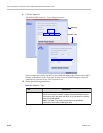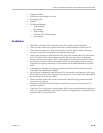
Polycom RealPresence Collaboration Server (RMX) 1500/2000/4000 Administrator’s Guide
21-32 Polycom, Inc.
3 Alarm Fault trap. The third trap type is a family of traps defined in the POLYCOM-
RMX-MIB file, these traps are associated with the RMX active alarm and clearance
(proprietary SNMP trap).
Figure 3 An Example of an Alarm Fault Trap
Each trap is sent with a time stamp, the agent address, and the manager address.
Status Trap
The MCU sends status traps for the status MAJOR - a trap is sent when the card/MCU
status is MAJOR.
All traps are considered “MAJOR”.
Defining the SNMP Parameters in the RMX
The SNMP option is enabled via the RMX Web Client application.
The addresses of the Managers monitoring the MCU and other security information are
defined in the RMX Web Client application and are saved on the MCU’s hard disk. Only
users defined as Administrator can define or modify the SNMP security parameters in the
RMX Web Client application.
To enable SNMP option:
1 In the RMX Web Client menu bar, click Setup > SNMP.
rmxFailedConfigUserListInLinuxAlarmFault notification received
from: 172.22.189.154 at 5/20/2007 7:04:22 PM
Time stamp: 0 days 00h:01m:11s.71th
Agent address: 172.22.189.154 Port: 32777 Transport: IP/UDP
Protocol: SNMPv2c Notification
Manager address: 172.22.172.34 Port: 162 Transport: IP/UDP
Community: public
Bindings (6)
Binding #1: sysUpTime.0 *** (timeticks) 0 days
00h:01m:11s.71th
Binding #2: snmpTrapOID.0 *** (oid)
rmxFailedConfigUserListInLinuxAlarmFault
Binding #3: rmxAlarmDescription *** (octets) Insufficient
resources
Binding #4: rmxActiveAlarmDateAndTime *** (octets) 2007-6-
19,16:7:15.0,0:0
Binding #5: rmxActiveAlarmIndex *** (gauge32) 2
Binding #6: rmxActiveAlarmListName *** (octets) Active
Alarm Table
* Binding #7: rmxActiveAlarmRmxStatus *** (rmxStatus) major


















